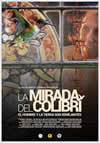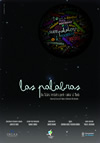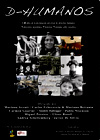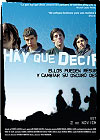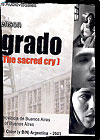Documentaries
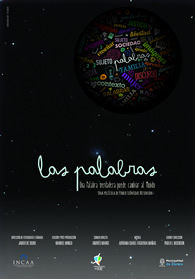
Una película de Pablo Leónidas Nisenson
Documental 82 min. (B/N & Color)
PRODUCIDO POR:
Pablo Leónidas Nisenson, Audiovisuales del Sur.
lectoescritura. La experiencia es registrada por un documentalista, quien, sumido en una aguda crisis personal, siente que también él debe empezar de nuevo, aprender a leer y a escribir.
| Director de Fotografía y Cámara; | JAVIER DE SILVIO, |
| Edición y Postproducción; | MANUEL MINGO, |
| Música; | ADRIANA ISABEL FIGUEROA MAÑAS, |
| Sonido directo; | ANDRÉS MARKS, |
| Guion y Dirección; | PABLO LEÓNIDAS NISENSON |
AUSPICIOS:
INSTITUTO NACIONAL DE CINE Y ARTES AUDIOVISUALES (INCAA)
MUNICIPALIDAD DE ZARATE
SECRETARIA DE DERECHOS HUMANOS DE LA NACIÓN

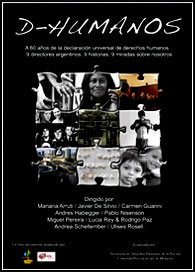
Produced by: Audiovisuales del Sur SRL con el apoyo del Instituto Nacional de Cine y Artes Audiovisuales.
Sponsored by: Secretaría de Derechos Humanos de la Nación.
Comisión Provincial por la Memoria.
Asociación civil TVgrafías.
Reg. Prop. Intelectual Nº 659565
| Technical tab | Documentary film |
| Format | Digital (HDV) - 35mm. |
| Duration | 93 min. Color |
| Directors | Mariana Arruti |
| Lucia Rey & Rodrigo Paz | |
| Carmen Guarini | |
| Andrés Habegger | |
| Pablo Nisenson | |
| Miguel Pereira | |
| Ulises Rosell | |
| Andrea Schellemberg | |
| Javier De Silvio | |

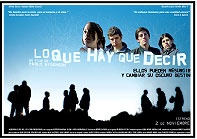
(35mm. color film, 82 min.) - 2006
Written and directed by Pablo Nisenson
Under the auspices of the Instituto Nacional de Cine y Artes Audiovisuales.
During a season of a year, seven young residents at a therapeutic community face a singular challenge: try to undergo a self-transformation.
All of them have to burden their history lives marked by deep conflictive familiar and social histories, drug addiction and, in some cases, by their tie to crime.
“What hast to be said” documents the difficult and sinuous process they have to carry on towards their own recovery, looking forward a different life.Shot in San Carlos de Bariloche and in Dina Huapi; in “Asumir” (Acceptance) - a rehabilitation clinic, and in “El Refugio de Jesús” (Jesus’ shelter) - a children’s home.
| Screenwriter and Director | Pablo Nisenson | Music Composer | Roberto Navarro | |
| Assistant Director | Verónica Montero | Sound Supervisor | Francisco Benincasa | |
| Producer | Andrea Elikir | Mix Supervisors | Jorge Stavropulos Javier Stavropulos |
|
| Executive Producer | Isidro Miguel | Title and Optical Designer | Matías Ghio | |
| Production Manager | Silvio Gressani | Production Accountant | María Fernanda Blasco | |
| Camera Operator / Still Photographer | Javier De Silvio | Unit Publicist | Denise Salvador | |
| Camera Operator Assistants | Maximiliano Curcu Pedro Larrea |
|||
| Film Editor | Manuel Mingo |

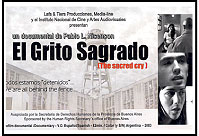
(TV feature film, 82 min.,
color / B&W).- 2003
Written and directed by Pablo Nisenson
First feature-length documentary ever to be shot in B.A. penitentiaries.
Under the auspices of the Instituto Nacional de Cine y Artes Audiovisuales.
Overview: Two youngsters, serving time for burglary in Argentine penitentiaries. A woman who is taken into custody for murdering her husband - a former oppressor and torturer. A film director who decides to make these life stories into movies and, by doing so, becomes aware of how people shut themselves away in the "world of freedom".
Reality and its reflection:
Today, in the province of Buenos Aires alone, there are around 30,000 people in jail, most of whom are between 18 and 21 years old - the most vulnerable age. Boys and girls who have grown up in enclaves of increasing poverty, with conflict-ridden family backgrounds and human rights, trampled on.
The sacred cry” is the reflection of such a reality, and the first full-length documentary shot in Argentine jailhouses.
| Young man in custody | Fabian Orozco |
| Mother | Stella Caruso y Toma |
| Young woman in custody | Marisa Larrea |
| Father | Pedro Larrea |
| Sister | Maira Larrea |
| Woman in custody | Cristina Alonso |
| Director | Pablo Nisenson |
| Witnesses | Dr. Elias Neuman José Pablo Feinman |
| Screenwriter and Director | Pablo Nisenson< |
| Executive Producer | Andrea Elikir< |
| Camera Operator / Still Photographer | Javier De Silvio< |
| Camera Operator Assistants | Gonzalo Gerardin Jonathan Gutierrez< |
| Sound Supervisor | Marcelo Viñas< |
| Editor | Manuel Mingo< |
| Music Composer | Roberto Navarro |
| Penitentiary Consultant | Dr. Juan Manuel Casolatti |

 It took part in the 1st DerhumALC Festival (Film Festival on Human Rights in the Mercosur Area, November, 2003) as well as in the 25th International Film Festival in La Habana, Cuba (December 2003). Not to mention, the 3rd National Film Festival in Tandil (September 2003).
It took part in the 1st DerhumALC Festival (Film Festival on Human Rights in the Mercosur Area, November, 2003) as well as in the 25th International Film Festival in La Habana, Cuba (December 2003). Not to mention, the 3rd National Film Festival in Tandil (September 2003).



